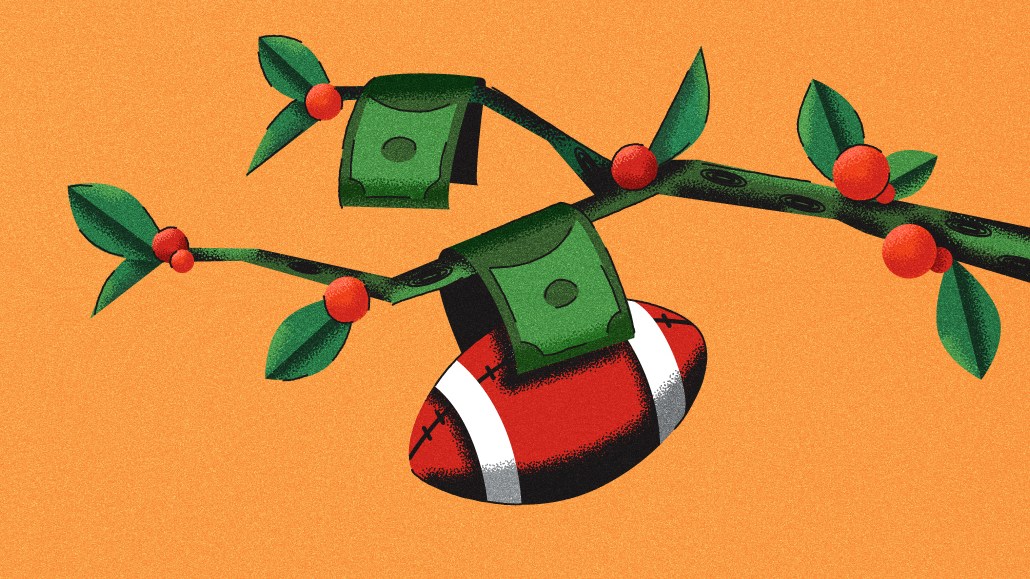Insights from CTV leaders at Dentsu, Horizon Media and more
The Athletic to raise ad prices as it paces to hit 3 million newsletter subscribers

As a Digiday+ member, you were able to access this article early through the Digiday+ Story Preview email. See other exclusives or manage your account.This article was provided as an exclusive preview for Digiday+ members, who were able to access it early. Check out the other features included with Digiday+ to help you stay ahead
The Athletic is about to hit 3 million total newsletter subscribers — nearly a 20% increase from this time last year. Its free, flagship weekly newsletter, The Pulse, now has 2.4 million recipients.
As a result of this audience growth, The Athletic has raised prices for its newsletters ads in 2023, though Lauren Funke, vp of advertising, declined to share by how much, calling it a “slight increase year over year.” The Athletic, which was acquired by The New York Times in 2022, will raise ad prices again this year as a result of the increase in newsletter subscribers. A NYT spokesperson later said that the Times is considering another price increase this year. This will be the second time prices will rise since The Athletic first started selling ads in 2022. She declined to share by how much or when the company was planning to set new prices.
Newsletter ads are sold as 100% share of voice, native newsletter ads directly to advertisers on a cost per day basis, Funke said. A New York Times spokesperson said the daily rate ultimately varies based on timeframe and newsletter product, declining to share a price range.
The Athletic’s newsletter advertisers are mostly in the luxury, finance, entertainment and CPG categories, according to Funke, including brands like Accenture, Chanel and Michelob ULTRA.
The Athletic currently has about 2.95 million total subscribers across its newsletter portfolio, according to the sports publication’s director of creative development Chris Sprow.
That kind of scale is extremely important when ad buyers consider where to buy newsletter ads. “That’s a sizable audience for a single media tactic. It offers advertisers an opportunity to garner large reach in a single day within quality content,” said Marcy Greenberger, chief investment officer at ad agency UM.
An ad agency exec, who asked to speak anonymously, said a “slight” price increase in newsletter ads as a result of subscriber growth may be warranted if a flat rate placement comes with an audience guarantee.
The Athletic’s eight weekly newsletters are free to read (a separate, automated daily digest newsletter is available to paying Athletic subscribers, featuring headlines on teams they follow). Other than The Pulse, the other seven weekly newsletters are only about a year old. The Pulse’s open rate ranges between 46-50%, according to Sprow, while its women’s soccer newsletter, Full Time, has an open rate of over 60%. The average open rate for newsletters in the media and publishing industry is 34%, according to email service provider MailChimp.
While The Pulse is not a paid newsletter, over a million paid subscribers to The Athletic receive it, Sprow said. He views the newsletters as a way to retain those subscribers and reduce churn by providing them with a “consistent flow of curated work” in a “snackable” format. The Athletic’s journalists will sometimes break news within their newsletters, Sprow said.
It’s also a way to get more readers to The Athletic’s site.
“Thousands of new [paid] subscribers to The Athletic last year came from our newsletters,” Sprow said. He declined to provide specific numbers and The New York Times declined to share how many paid subscribers The Athletic has.
Traffic to the site has certainly grown in the past year, though. The Athletic had 17.6 million U.S. unique visitors in March 2024, up from 6.6 million in March 2023, according to Comscore data.
Newsletter ad revenue has grown in the past year, Sprow and Funke said, though neither of them would share by how much. However, the majority of newsletter ad buys tend to be part of larger ad packages sold to brands that span digital, social, video and audio, Funke said. By default, “we were putting a newsletter on every plan,” she added. “If an advertiser says that they don’t want to receive a newsletter on their plan, we will take that out. But it is such an essential part of the whole ecosystem.”
More newsletters are set to debut this year for the sports publisher, as well as franchises extending from the existing portfolio. A podcast from Full Time — which started as a special edition newsletter for the Women’s World Cup, then became a full-time offering — is relaunching next month with a new co-host, Funke said. A sports business vertical will debut on The Athletic’s site in the fourth quarter of this year, along with a new newsletter, she added.
“The more impressions to relevant, engaged individuals, the better. While newsletters may have lower reach than the open web, they can help with incremental reach to the audience through a different medium,” said Allie Kelly, svp of performance media at ad agency Publicis Collective.
More in Media

Ad Tech Briefing: The ‘plumbers’ posing as the unlikely saviors of the internet
After several false dawns, can Cloudflare’s ‘anti-AI scraping tool’ finally offer publishers a road to commercial redemption?

Generative AI, not ad tech, is the new antitrust battleground for Google
Global regulatory scrutiny is shifting from Google’s ad tech and search dominance to generative AI, as they aim to address the most pressing threats to publisher business models.

Yahoo takes cues from platforms as it offers more editorial control to creators
Through its creator program, Yahoo is evolving from its roots as a content aggregator and editorial publisher to more of a distribution platform for individual creators.








